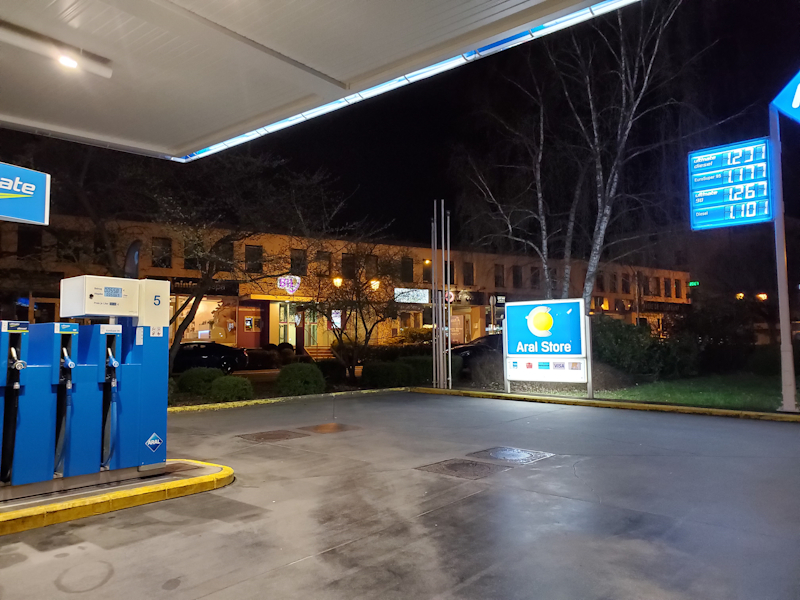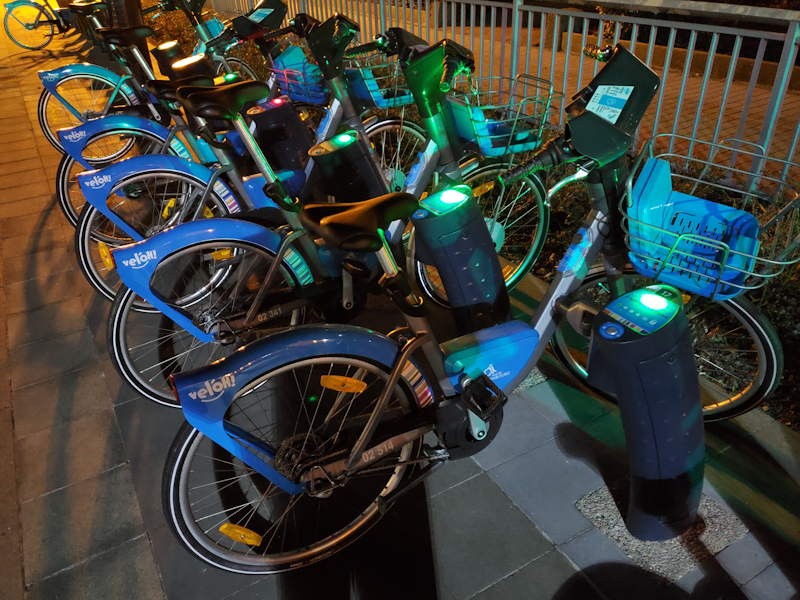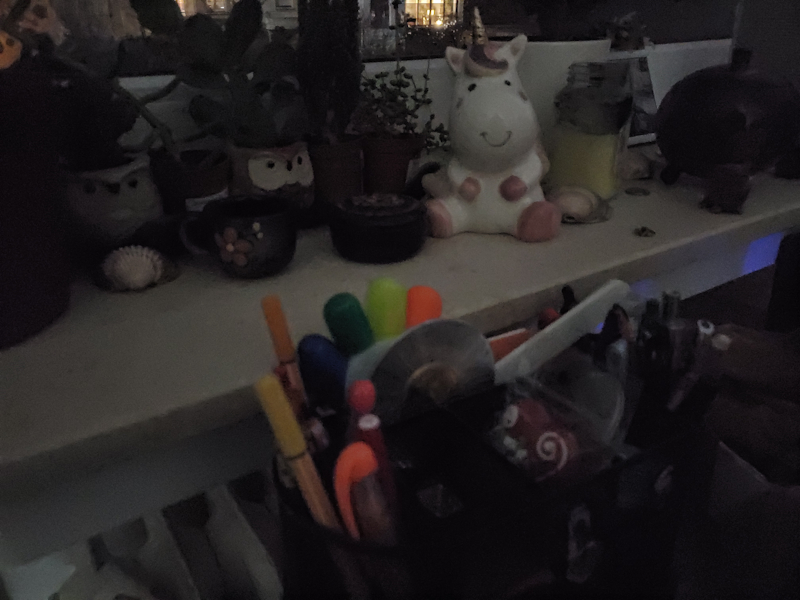The Samsung Galaxy S10+ Snapdragon & Exynos Review: Almost Perfect, Yet So Flawed
by Andrei Frumusanu on March 29, 2019 9:00 AM ESTCamera - Low Light Evaluation
Low-light capture improvements is something that Samsung has been very mum about for the Galaxy S10. Fundamentally on the hardware side of things nothing has really improved compared to the Galaxy S9/Note9. So in practise, any difference we would be seeing should be solely based on the processing improvements of the Galaxy S10.

[ Galaxy S10+ Snapdragon ] - [ Galaxy S10+ Exynos ]
[ Galaxy Note9 (E) ] - [ Galaxy S9+ (S) ] - [ Galaxy S8 ]
[ iPhone XS ] - [ iPhone X ] [ LG V40 ] - [ OnePlus 6T ]
[ Pixel 3 ] - [ View20 ] - [ Mate 20Pro ]
In the first shot, we’re seeing again very different results between the Snapdragon and Exynos, but in a twist compared to the daylight shots, this time around it’s an advantage on the side of the Exynos model. Here the latter models is able to bring out a lot more shadows in the scene and is significantly sharper than the Snapdragon variant. The Snapdragon does a bit better on the bright highlights of the signage, however I don’t think this was worth it as it gives up too much in other parts of the shot.
I feel as if the Snapdragon has quite a bit of sharpening going on, which makes very little sense to use in a scenario like this.
The Galaxy S10’s are both beat by the Mate 20 Pro’s large sensor which just has much better native dynamic range, retaining more texture details on the gas station floor and roof.
Using the wide-angle lens in such a scenario doesn’t result in very good picture. The Snapdragon achieves better dynamic range and able to show the signage correctly without overblowing it, however the Exynos beats it in terms of detail. Noise on the latter is a lore more coarse and pronounced which can result in some ugly regions on even surfaces.

[ Galaxy S10+ Snapdragon ] - [ Galaxy S10+ Exynos ]
[ Galaxy Note9 (E) ] - [ Galaxy S9+ (S) ] - [ Galaxy S8 ]
[ iPhone XS ] - [ iPhone X ] - [ LG V40 ] - [ OnePlus 6T ]
[ Pixel 3 ] - [ View20 ] - [ Mate 20Pro ]
Big advantages in sharpness on the bright parts of the picture for the Snapdragon with stronger contrast for this phone. The Exynos doesn’t do well on the bright parts, blurring them, but on the other hand it has better details in the shadows than the Snapdrgon, with overall less pronounced light noise.
In terms of light capture, the Mate 20 Pro is far ahead and Night Sight on the Pixel 3 also sweeps the floor with the competition.

[ Galaxy S10+ Snapdragon ] - [ Galaxy S10+ Exynos ]
[ Galaxy Note9 (E) ] - [ Galaxy S9+ (S) ] - [ Galaxy S8 ]
[ iPhone XS ] - [ iPhone X ] - [ LG V40 ] - [ OnePlus 6T ]
[ Pixel 3 ] - [ View20 ] - [ Mate 20Pro ]
The Snapdragon here is heavier processed with darker shadows and noise reduction, however this makes little sense in a low-light show and the Exynos is more natural with better shadow detail even if it has more natural sensor noise.
Although Samsung at least beats the newest iPhones, it’s no match for Huawei and the Pixel’s Night sight.

[ Galaxy S10+ Snapdragon ] - [ Galaxy S10+ Exynos ]
[ Galaxy Note9 (E) ] - [ Galaxy S9+ (S) ] - [ Galaxy S8 ]
[ iPhone XS ] - [ iPhone X ] - [ LG V40 ] - [ OnePlus 6T ]
[ Pixel 3 ] - [ View20 ] - [ Mate 20Pro ]

[ Galaxy S10+ Snapdragon ] - [ Galaxy S10+ Exynos ]
[ Galaxy Note9 (E) ] - [ Galaxy S9+ (S) ] - [ Galaxy S8 ]
[ iPhone XS ] - [ iPhone X ] - [ LG V40 ] - [ OnePlus 6T ]
[ Pixel 3 ] - [ View20 ] - [ Mate 20Pro ]
In the last generic low light shot we see the Snapdragon again favour evening out highlights and sacrificing shadows. The Exynos does the opposite with more blown out highlights but with better shadow detail retention in the foreground.
On the wide angle, the Exynos produces a much more useable shot even though the noise is quite terrible.

[ Galaxy S10+ Snapdragon ] - [ Galaxy S10+ Exynos ]
[ Galaxy Note9 (E) ] - [ Galaxy S9+ (S) ] - [ Galaxy S8 ]
[ iPhone XS ] - [ iPhone X ] - [ LG V40 ]
[ OnePlus 6T ] - [ Pixel 3 ]
[ View20 ] - [ Mate 20Pro ]
Going into extreme low light scenarios, we’re venturing into shots that usually in the past we didn’t expect phones to be able to capture.
This is the first scene in which Samsung’s new Bright Night mode triggers. The new extreme ultra low light mode functions similarly to Huawei’s Night mode or Google’s Night sight, although the results here aren’t quite the same. The result here heavily favour the Snapdragon chip as it’s able to produce much less noise. It’s not competing with Huawei or Google, however it is able to showcase a result that is much better than some other traditional shooters.

[ Galaxy S10+ Snapdragon ] - [ Galaxy S10+ Exynos ]
[ Galaxy Note9 (E) ] - [ Galaxy S9+ (S) ] - [ Galaxy S8 ]
[ iPhone XS ] - [ iPhone X ] - [ LG V40 ] - [ OnePlus 6T ]
[ Pixel 3 ] - [ View20 ] - [ Mate 20Pro ]
A second example of the new Bright Night mode, we again see that it does help the S10 over its auto mode and it lands the phone in third place after Huawei’s flagship and Google’s Night Sight.
Low-light Conclusion
Overall, the low-light capture ability of the Galaxy S10 isn’t very exciting. Fundamentally Samsung needed to innovate more in this regard and I would have wanted to see some more innovation to the likes of Huawei and Google.
Low-light is again a scenario where the Snapdragon and Exynos variants of the S10 differ quite a bit. The latter tends to produce more natural noise in most shots and retains more shadow detail, while the Snapdragon does better in brighter parts. Overall, I’d say it’s a toss-up between the two and it’ll depend on the given scene.










229 Comments
View All Comments
Azurael - Saturday, March 30, 2019 - link
"the M4 cores should very much be quite a lot more efficiency than the A75 cores"*brain explodes*
Samus - Sunday, March 31, 2019 - link
They should have gone with a pop-out camera than the hole punch. Hate to say it but apples notch was the best solution other than a pop-up camera.Javert89 - Sunday, March 31, 2019 - link
Just a precisation. Adreno 640 do not have 50% more execution units, indeed it should be the usual 2 core design seen in the 630.. only the Adreno of the bigger Snapdragon 8cx has 3 cores plus a 128 bit memory controllerAndrei Frumusanu - Sunday, March 31, 2019 - link
It *does* have 50% more execution units / ALUs; https://images.anandtech.com/doci/13680/Screenshot...bjtags - Sunday, March 31, 2019 - link
Huawei Mate SE 99% of this for 1/4 the Price.....s.yu - Monday, April 1, 2019 - link
Entirely laughable.tipoo - Sunday, March 31, 2019 - link
The efficiency + performance of the A12 even in comparison to this continues to be crazy, and we're on the other side of the year of that launching.I'd be really interested to see that put against x86 cores in SPEC2006
name99 - Monday, April 1, 2019 - link
Here you are. Not a PERFECT comparison but the best currently available:https://www.anandtech.com/show/13392/the-iphone-xs...
https://www.anandtech.com/show/11544/intel-skylake...
Would be great if we had comparison graphs, and if it were compiler to compiler (both LLVM) and if it were desktop cores, and if it were Coffee Lake, and ...
But as I said it's the best available right now.
Basically (especially if Apple adds SVE to their desktop ARM core) they probably have nothing to fear in terms of reduced performance by switching to the A12 successor.
s.yu - Monday, April 1, 2019 - link
I gotta say I'm surprised from the first sample that the S9+ was the best among the Samsung's and very, very close to Pixel performance which is still overall No.1, S10PS only comes second, S10PE is about as bad as the Note9, I think some of these have defective lenses with especially bad resolution on the edge(s)...the difference is much smaller in the center of the frame. So it could be said that even with the f/2.4 aperture, the Samsung's lens has QC issues that aren't masked. It would be interesting to see how P30P's f/1.6 lens fares.S9+ didn't stand out so much in the HDR scenes though, but from the landscapes I'd say the S9+ probably got an especially good lens sample, better than the S10PS and much better than the S10PE. How the Pixel reproduces texture is just incredible, though many of the scenes are rendered darker, there's little sign of the crushed black issue, i.e. it's just darker, but high quality, it's still my definition of realistic among almost any smartphone output, it would obviously stand better to sharpening or NR in post.
Regarding the wide shots...HDR's the differential. The S10PS outperformed the Mate20P despite a wider FoV in most of the landscape samples, but failed to do so in the shot under the bridge.
IMO in low light shots the PS still wins overall, to the PE, PE seems to have issues mapping black (with minimal actual shadow advantage) while in the midtones as both win in certain instances it's a toss. Still nothing beats the Pixel...Mate20P's auto was especially bad in the maintenance center shot, that was interesting considering the sensor size.
And I have to disagree just from the first night sample that the PS isn't matching Mate20P's night mode, it's evident that it did a poor job on the sand, but *everything else* on the frame is better, the subject, the houses in the background, the light posts. It is clear in the second night mode shot with a low DR range though, that the Samsung's messed up.
lty0432 - Monday, April 1, 2019 - link
Hi author !I think this kind of technical articles on Exynos and SD has been best out there.
Can I possible get your opinion on how mobile processors stack up against PC processors ?
Are there any benchmark comparison articles ?